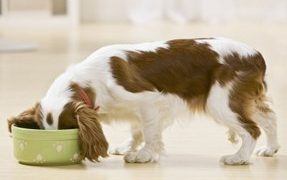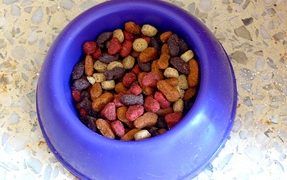“This post contains affiliate links, and I will be compensated if you make a purchase after clicking on my links.”
In this third and final article concerning the dry vs. wet vs. natural dog food issue, why don’t we take a look at what constitutes each type of food and how they can benefit puppies to adult dogs.
One question many people have ask is “should I feed dry or wet (canned) dog food”? It is a question I have wondered about myself and what I have learned is some dogs like dry while others prefer wet. I combine a can of quality dog food with my dog’s dry food about 3 times a week. This insures they have a bit of variety at dinner time and provides plenty of nutrition to cover those days they snub eating strictly dry food. Feeding dry dog food only helps keep your dogs teeth clean and provides nutrition in a more concentrated form, plus it is cheaper per serving.
Canned dog foods have higher moisture content as well as being very soft, thus canned/wet foods are better for older dogs with poor teeth, dogs with digestive issues, and those pets with urinary tract concerns. You will pay more for premium canned foods but a big plus is they have a very long shelf life. Keep in mind all dry dog foods will have starch as one of the ingredients, semi-wet will have sugars and canned will contain higher levels of fats.
When thinking about the dry vs. wet. vs. natural dog food debate many people are uneducated concerning just what “natural, holistic, or organic dog foods” are, as this is a relatively new arrival in the mass market. Simply put these are dog foods with high prices containing no synthetic ingredients. All ingredients are organic and natural sources of food such as vegetables and select cuts of meats without any of the byproducts found in many other dog foods. If you decide to go this route when selecting the best food for your dog, most vets highly recommend you add a quality vitamin containing the minerals and various vitamins your dog needs for maintaining optimal health.
What choice you make is going to be up to your dog’s age, medical condition, over or under weight, etc. Try to avoid the common mistake of over feeding and when you do make changes to your dog’s diet introduce the new foods gradually over a seven to 14 day period by mixing the new food with the old food. This all might seem complicated, but educating yourself about dry vs. wet vs natural dog food is not difficult. Just takes a bit of time on your part and after all, isn’t your beloved fur baby worth the effort?

















Amanda, CVT
Jan 16, 2013 at 12:08 pm
“Feeding dry dog food only helps keep your dogs teeth clean and provides nutrition in a more concentrated form, plus it is cheaper per serving”
False. Dry dog food does not clean your dog’s teeth any more than chewing granola every day is a substitute for brushing your own teeth. If it were true, we would theoretically not need to clean the teeth of dry-fed dogs as much as those fed other diets. But this is simply not the case. If anything, dry food contains a lot of starches that can stick TO your dogs teeth, and most dogs are not good about chewing kibble anyway, which means that the theoretical abrasive mechanical chewing action doesn’t come into play.
Also, most canned food is more nutrient dense. Think about it: dry dog food has fillers and components added solely for the purpose of making the food kibble form, dry, and easily stored. Canned food (good ones anyway) will be meat and veggies, in a can. Which one has more bioavailable nutrients per serving? You also may find you feed LESS canned food, so it’s not even more expensive sometimes.